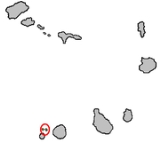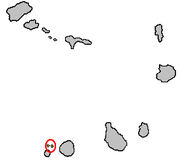
Ilhéus Secos
Encyclopedia
| Ilhéus Secos | |
|---|---|
 |
|
| Population: | Uninhabited |
| Elevation Elevation The elevation of a geographic location is its height above a fixed reference point, most commonly a reference geoid, a mathematical model of the Earth's sea level as an equipotential gravitational surface .... : |
121 m |
| Location: | Cape Verde Cape Verde The Republic of Cape Verde is an island country, spanning an archipelago of 10 islands located in the central Atlantic Ocean, 570 kilometres off the coast of Western Africa... , north of Brava Brava, Cape Verde Brava is an island in Cape Verde. It is the smallest inhabited island, but at the same time the greenest, of Cape Verde, in the Sotavento group. First settled in the 1540s, its population grew after Mount Fogo on neighbouring Fogo erupted in 1675... |
| Range Mountain range A mountain range is a single, large mass consisting of a succession of mountains or narrowly spaced mountain ridges, with or without peaks, closely related in position, direction, formation, and age; a component part of a mountain system or of a mountain chain... : |
none |
| Type: | stratovolcano |
Ilhéus Secos (Portuguese
Portuguese language
Portuguese is a Romance language that arose in the medieval Kingdom of Galicia, nowadays Galicia and Northern Portugal. The southern part of the Kingdom of Galicia became independent as the County of Portugal in 1095...
meaning Dry Islets, because the islets are dryer and do not have as much vegetation as the Brava island) or Ilhéus do Rombo are a group of islets in Cape Verde
Cape Verde
The Republic of Cape Verde is an island country, spanning an archipelago of 10 islands located in the central Atlantic Ocean, 570 kilometres off the coast of Western Africa...
located due north at about 7 to 8 km from the nearby island of Brava
Brava, Cape Verde
Brava is an island in Cape Verde. It is the smallest inhabited island, but at the same time the greenest, of Cape Verde, in the Sotavento group. First settled in the 1540s, its population grew after Mount Fogo on neighbouring Fogo erupted in 1675...
. The two major islets of the chain include Ilhéu Grande
Ilhéu Grande
Ilhéu Grande is part of the Ilhéus Secos islet group. Its location is in the west and it represents the largest islet of the chain. The etymology or its origin of name is the big islet in which is the largest islet of the chain...
and Ilhéu de Cima
Ilhéu de Cima
Ilhéu de Cima is part of the Ilhéus Secos islet group. Its location is in the east and it represents the second largest islet of the chain. They are administratively a part of the municipality of Brava...
. Other islets include three of them are in the rest of the area. They are administratively a part of the municipality of Brava. The island is a volcanic seamount.
Geography
The islets contains dry grasslands and rocky coastlines. The Ilhéu Grande is situated in the west side and is the largest of the chain, its length is around 1.5 km from southwest to northeast and the width is approximately 600 to 800 m from east to west, this islet is ranked the largest and contains a small bay on the island's northwestern part. The middle part contains two small islets of little or no vegetation. The Ilhéu de Cima is around 1 km in length going south to north and about 500 to 600 m from east to west and is the second largest. A small bay is lying in the southeast, another islet is only about 500 m northeast and contains little or no vegetation. Other islets include Ilhéu do Rei, Ilhéu Sapado, Ilhéu Luíz CarneiroPanorama
The islets can definitely be seen from the northern part of BravaBrava, Cape Verde
Brava is an island in Cape Verde. It is the smallest inhabited island, but at the same time the greenest, of Cape Verde, in the Sotavento group. First settled in the 1540s, its population grew after Mount Fogo on neighbouring Fogo erupted in 1675...
and in the northern Fontainhas mountain range. The islets can rarely be seen in the higher elevations of the western part of the island of Fogo
Fogo, Cape Verde
Fogo is an island in the Sotavento group of Cape Verde. It is the most prominent of the group, rising to nearly 3,000 m above sea level at Pico do Fogo.-Geography:...
.
Nearest islands and islets
- FogoFogo, Cape VerdeFogo is an island in the Sotavento group of Cape Verde. It is the most prominent of the group, rising to nearly 3,000 m above sea level at Pico do Fogo.-Geography:...
, southeast - BravaBrava, Cape VerdeBrava is an island in Cape Verde. It is the smallest inhabited island, but at the same time the greenest, of Cape Verde, in the Sotavento group. First settled in the 1540s, its population grew after Mount Fogo on neighbouring Fogo erupted in 1675...
, south

